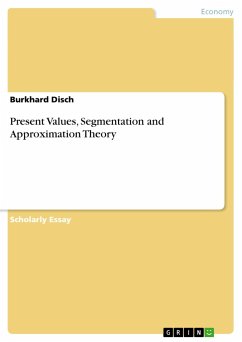Scientific Essay from the year 2005 in the subject Business economics - Banking, Stock Exchanges, Insurance, Accounting, Deutsche Gesellschaft für Versicherungs- und Finanzmathematik e.V. , language: English, abstract: SummaryThis paper describes a method for computing present values for a part (segment) of a given collective with the help of the corresponding present value for the whole collective. The algorithm is given by introducing a special norm via an inner product from the present value of the whole collective. The integral is solved by approximating a function which shows the selection and the best approximation on the integrand for the present value of the whole collective. Examples demonstrate the procedure.ZusammenfassungBarwerte, Segmentierung und ApproximationstheorieInhalt der Ausarbeitung ist eine Methode zur Berechnung der Barwerte für ein segmentiertes Kollektiv unter Benutzung des entsprechenden Barwertes für das ganze Kollektiv. Der Algorithmus ist definiert über eine Norm auf dem Raum der mindestens einmal stetig differenzierbaren Funktionen, induziert über ein Inneres Produkt, definiert unter Zuhilfenahme des Barwerts für das gesamte Kollektiv. Das der Barwertberechnung zugrundeliegende Integral wird durch einfache Auswertung eines geschlossenen Funktionsausdrucks - der aus der expliziten Lösung des Integrals folgt - und der besten Approximation bezüglich der so definierten Norm berechnet. Beispiele demonstrieren die Vorgehensweise.








